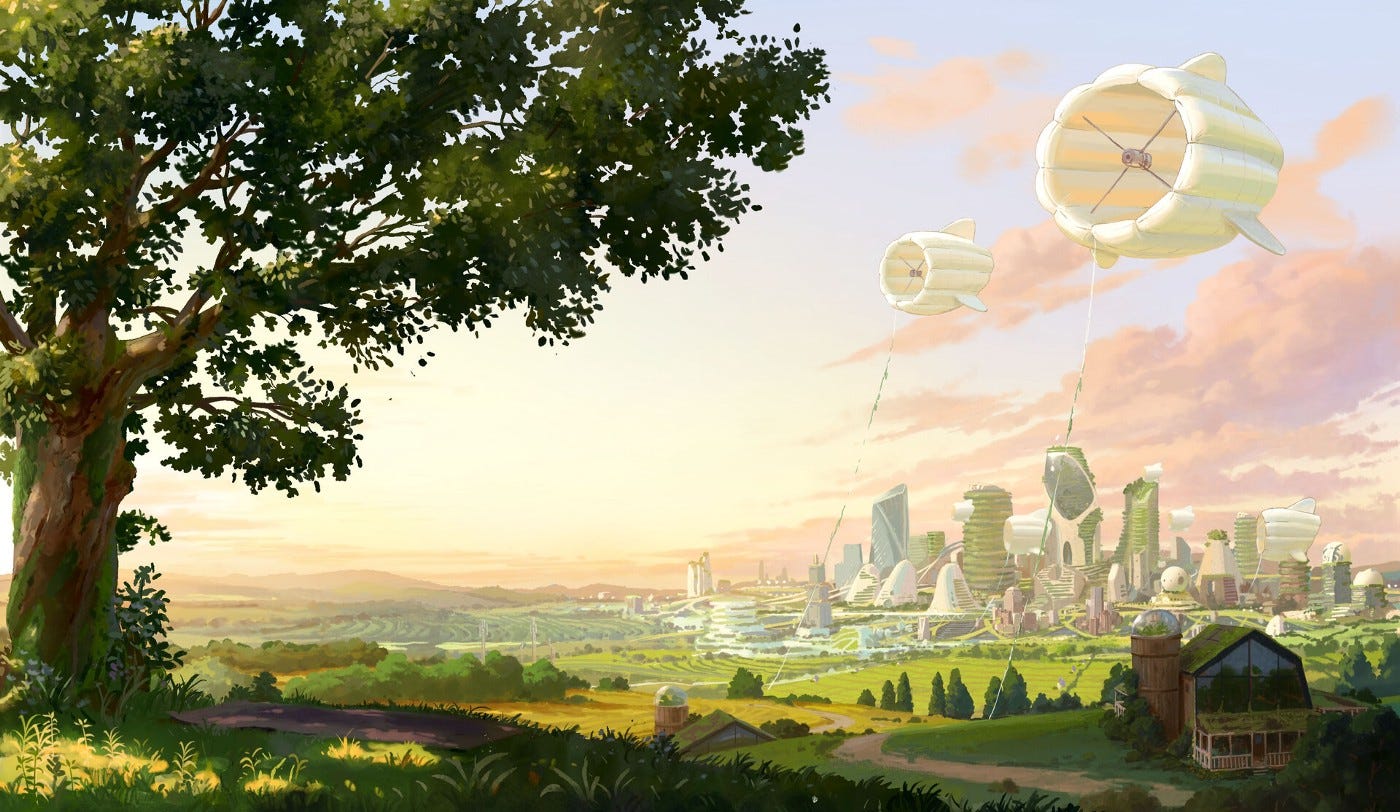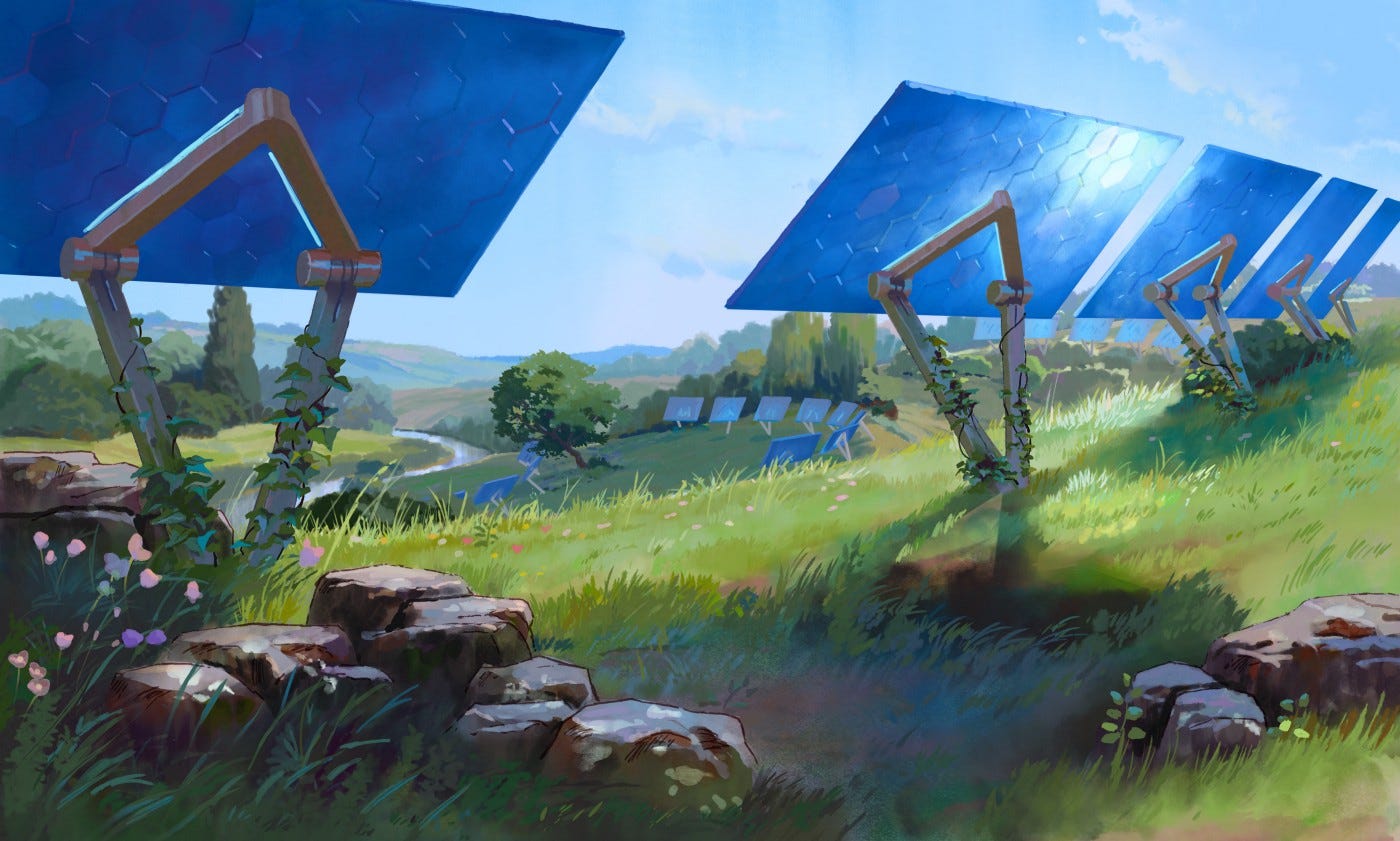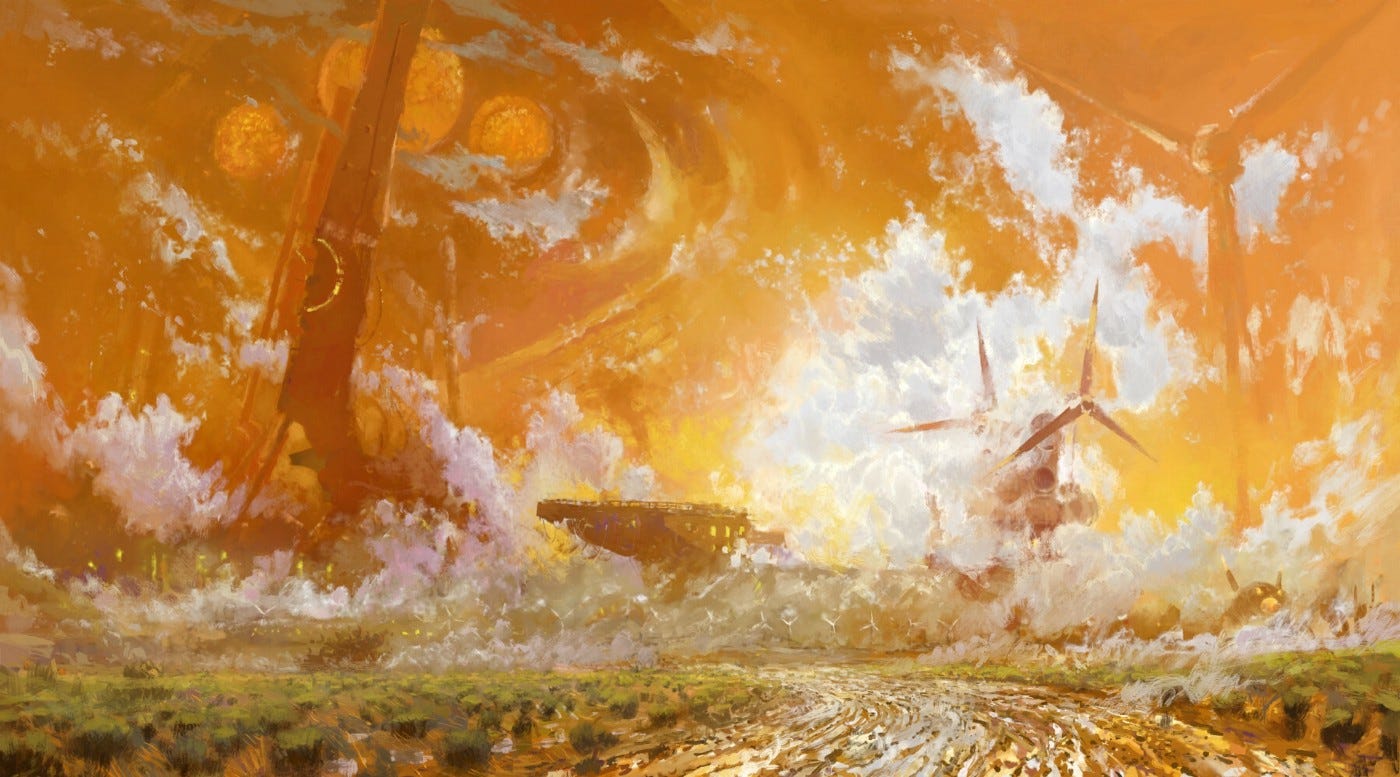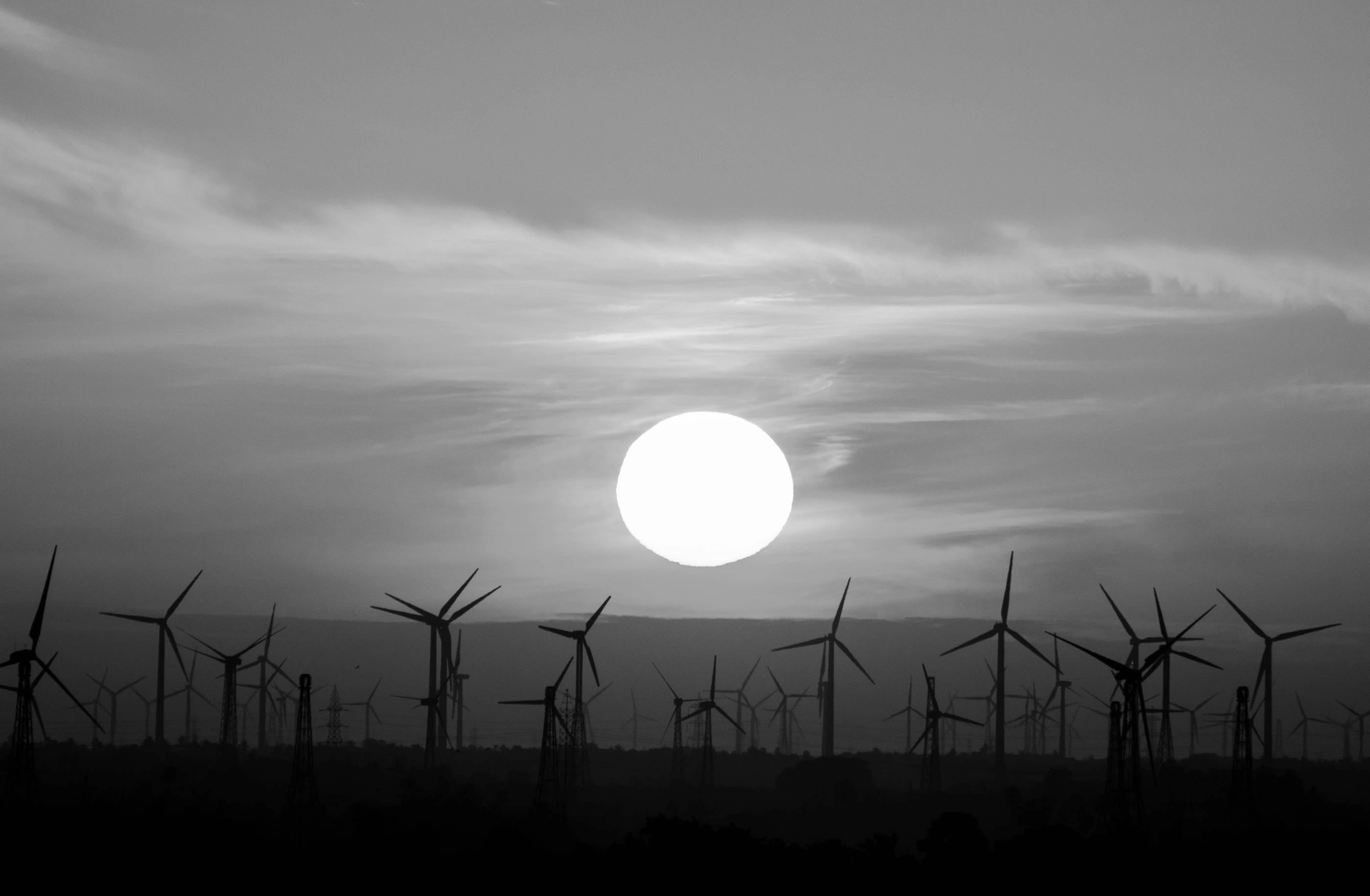Solarpunk wants to change the world — should we take it seriously?
Can an (overly) optimistic science fiction genre help inspire a new generation of Leftists?
The world appears bleak right now. Conflicts, wars, famines, discrimination, division, economic decline — the list goes on and on. The future, much like the present, provides little reason for optimism. Apathy and impotence have become the status quo.
Well, that is precisely where Solarpunk comes into play.
Solarpunk is a movement of hope and a return to harmonious coexistence with the planet — without hierarchies, capitalism, and the destruction of our environments and children’s futures. It signifies a receding back to nature and the things that truly matter in life.
Today, let us dive deeper into the topic and examine its potential for change.
Note: This essay is the second part of my Solarpunk series. You can read the first part here:
Okay, so what is Solarpunk?
The answer to this question can be both simple and complex. Let’s begin with a simple definition: At the moment, Solarpunk is still primarily a fictional genre. A genre that, roughly speaking, has positioned itself as the antithesis to Cyberpunk.
Instead of devastated, ultra-capitalist dystopias, Solarpunk represents a utopia in which humanity and nature exist in harmony. Solarpunk worlds, for the most part, are no longer capitalist. They do often involve sophisticated technologies, but these are to be utilized in sustainable and mutually beneficial manners.

However, Solarpunk has evolved into more than that. It has reached into the real world. Solarpunk is activism. Solarpunk is exactly what its name implies: punk. It’s a counter-movement to our profit- and growth-oriented society.
Solarpunk is anti-capitalist, ecological, anarcho-communist, communal, and socialist — as you can see, it’s a lot of different things.
Solarpunk activism can take many forms: mutual aid, community projects, self-organization, decentralization, urban and guerrilla gardening, sustainable designs, green technologies, and a variety of other things. Solarpunk is diverse — and thus can help bring people together. It’s a movement that has yet to find its footing. An evolving movement that everybody can help shape.
A short history of Solarpunk
As mentioned, Solarpunk, both as a genre and as a social movement, is still in its infancy. While several classic novels feature strong Solarpunk connotations (Ursula K. Le Guin’s The Dispossessed might be a prime example), they were not written under that banner at the time. In general, several novels from the New Weird era, at least in principle, are Solarpunk. As are some of Hayao Miyazaki’s movies (one of Studio Ghibli’s co-founders).
Before Solarpunk, however, there was Ecopunk, which emerged as a distinct fictional genre in the early 2000s. The term Solarpunk was then coined, popularized, and likely used for the first time back in 2008, when the blog ‘Republic of the Bees’ published an essay titled From Steampunk to Solarpunk.

In 2014, a Tumblr blog started posting Solarpunk-related artworks and aesthetics. This massively increased the genre’s visibility on the platform (which, back then, had far more users than today) and resulted in several Solarpunk books — mostly anthologies — which were released over the following years. A new genre seemed born.
It did not, however, comprise a movement yet.
That changed in 2019 when the Solarpunk Manifesto appeared — Solarpunk: Notes toward a manifesto was published five years earlier, true, but it was the 2019 version that had a lasting impact. The manifesto embraced Solarpunk as a radical social movement and possible vision of the future and, in the process, defined many of its fundamental goals and characteristics.
Solarpunk as a literary and artistic genre
Solarpunk as a genre can be many things, too, but at its core, it’s all about worlds in which humanity thrives in harmony with its surroundings without reverting to pre-industrial-style subsistence economies. This implies an abundance of renewable energy, some of which is generated in conventional ways and some of which is based on futuristic technologies such as flying wind turbines or clean fusion reactors. Environmental destruction and pollution are things of the past.

Typically, Solarpunk stories can be attributed to the broader science fiction or fantasy genres, and, in their purest iterations, play out in post-capitalist and post-hierarchical utopias where there is little cause for conflict or drama. A somewhat challenging backdrop for (aspiring) writers and authors such as myself.
By the way: since Solarpunk is strongly anti-colonialist in nature and thus embraces indigenous cultures and ways of living, it frequently overlaps and intersects with the niche genre of Afrofuturism. The Marvel film Black Panther, for example, contains several Solarpunk-ish elements.
Solarpunk as a political and environmental movement
While artistic and literary interpretations can be significant and influential, it’s the political and social arguments that truly define Solarpunk. Well, how do Solarpunks compare to other environmental and/or political activists?
To begin, one could argue that the Fridays for Future movement incorporates many aspects of Solarpunk, as it now increasingly encompasses not only environmentalism but also anti-capitalism and anti-colonialism. However, Fridays for Future remains first and foremost an environmental organization. While they do address the exploitation of nature and people through capitalist mechanisms, these political thoughts are not quite pronounced.
Extinction Rebellion is heading in the same direction, regarding itself primarily as an apolitical movement and being frequently (and rightly) criticized on this basis.
In this essay, I want to define Solarpunk as both a political and environmental movement. As such, it is under obligation to cooperate not only with environmental groups such as Fridays for Future or Extinction Rebellion, but also, and, in fact, much more so, with socialist, communist, and anarchist organizations. At its core, the Solarpunk agenda must be anti-capitalist. There is no alternative.
Some see Solarpunk as a bourgeois, sometimes even neoliberal, movement. I strongly distance myself from this point of view. I see Solarpunk as an optimistic, albeit at times unrealistic, vision of the future. Not more and not less. As such it can be a valuable ally and (let’s use a controversial expression for it) useful tool of propaganda for Leftist organizations.
Politics and environmental concerns are not separate issues but inextricably linked. No sustainable world can be built unless the political and economic systems that govern it undergo radical change.
Solarpunk activism
As stated before, Solarpunk activism entails a wide range of activities that can be undertaken by anyone, at any time, and with relative ease. One example is the organization in local communities (e.g. neighborhood co-ops) to manage community gardens, grow various types of food, build shared power supply systems, and so on.
It’s all about self-sufficiency and mutual aid.
Guerrilla gardening, which involves planting local wildflowers and the like in public places, is also part of the Solarpunk mindset. Trimmed and mowed lawns, the subjugation of nature, the wasteful use of resources, and any forms of discrimination, on the other hand, are the enemy.
As Solarpunk contains strong anarchist components, it naturally taps into mutual aid and other forms of community organization. Community members offer each other help and assistance, conduct repairs, share resources, care for children and the elderly, and so on. Everybody contributes in accordance with their skills and talents.
In short: it’s what capitalism was supposed to do, but has failed to do.
Sometimes, a vision is all we need
Solarpunk can be important. While many of us have already come to terms with a dystopian future — or, let’s face it, a dystopian present — Solarpunk is providing a glimmer of hope. It paints a different outlook. It shows us what this world could look like.
Is it realistic? Is it possible? — No, I don’t think so. I’m sorry but I don’t. When I look into the future, I see the collapse of modern society and small pockets of self-sustained communities. But nothing of the Solarpunk sort. Nothing with those levels of technological sophistication and complexity.
Still, I like Solarpunk. It’s why I write about it. And I do think it can be useful. A vision can sometimes be more powerful than any amount of hard communist theory or anarchist praxis. It’s only human.
I’m author, writer, and activist Antonio Melonio, the creator of Beneath the Pavement. If you enjoyed this piece, please consider becoming a paid subscriber here on Substack or over on Patreon. It’s the best way to support Beneath the Pavement and help me put out more and higher-quality content.
If monthly contributions are not your thing (I understand), you can also leave me a tip or some coffee money over on PayPal. Thank you.
Sources and further reading
Mark Montegriffo in Jacobin. Yes, “Socialism or Extinction” Is Exactly the Choice We Face. https://jacobinmag.com/2020/09/extinction-rebellion-socialism-capitalism
Marquardt, J. (2020). Fridays for future’s disruptive potential: an inconvenient youth between moderate and radical ideas. Frontiers in Communication, 5, 48.
Miss Olivia Louise (Tumblr). Here’s a thing I’ve had around in my head for a while! https://missolivialouise.tumblr.com/post/94374063675/heres-a-thing-ive-had-around-in-my-head-for-a
Regenerative Design. A Solarpunk Manifesto. https://www.re-des.org/a-solarpunk-manifesto/
Republic of the bees. From Steampunk to Solarpunk. https://republicofthebees.wordpress.com/2008/05/27/from-steampunk-to-solarpunk/
Solarpunk subreddit. https://www.reddit.com/r/solarpunk/
VICE. Solarpunk Is Not About Pretty Aesthetics. It’s About the End of Capitalism. https://www.vice.com/en/article/wx5aym/solarpunk-is-not-about-pretty-aesthetics-its-about-the-end-of-capitalism






Let's hope.
This prompted me to look up some retrospectives for Veridian design, which seems quite similar to your description of solarpunk, except without the connection to radical politics: https://medium.com/5-viridian-years/aade6358664b
Does that seem like a fair comparison to you?